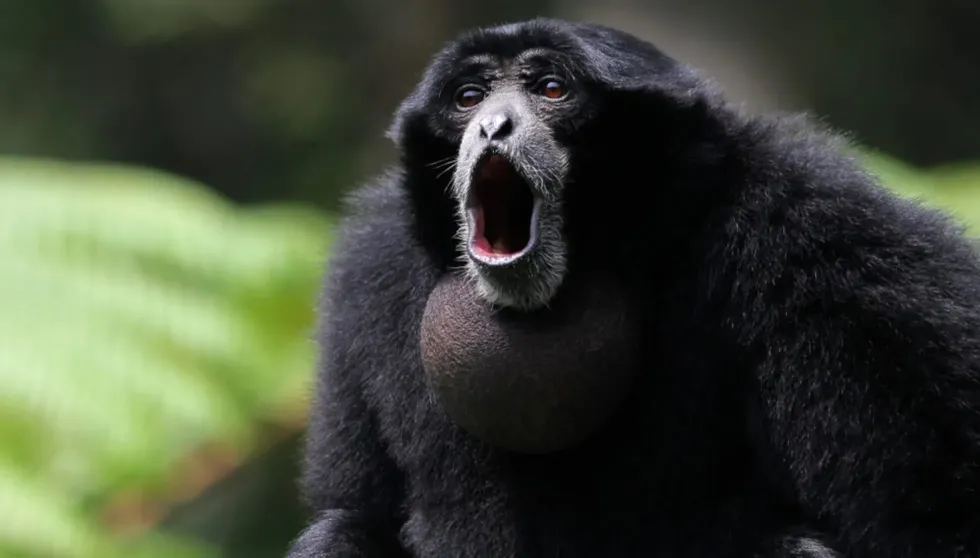The siamang (Symphalangus syndactylus) is a gibbon species in the order of primates, mostly found in the forests of Malaysia, Indonesia, and Thailand. They are the largest gibbon species and are twice the size of other gibbons most of the time.
This black-furred ape with much longer arms than legs can weigh up to 35.274 lb (16 kg) and is known for its singing and vocalizing using its special throat sac.
They look very similar to monkeys, but are arboreal, living and traveling mostly in trees.
These gibbons, siamangs, are not the same as chimpanzees, gorillas, orangutans, and humans, as they have just two fingers on each hand. They live in rain forests and monsoon forests on upper treetops and are diurnal.
The siamang gibbon has a slender body and lightweight bones which makes them great at swinging. The siamang's hands and legs also make it easier for them to grab and hold onto things.
These animals were once abundant in their native forests but due to an increase in palm oil production, the habitat of these gibbon species has been reduced to a minimum. Their population has gone down a lot as a result.
Why not learn some interesting facts about the gibbon and cougar here on Kidadl too?
Siamang Gibbon Interesting Facts
What type of animal is a siamang gibbon?
Siamang gibbons are a species of gibbons of the order of primates and are part of the genus Syndactylus.
What class of animal does a siamang gibbon belong to?
Siamang gibbons fall under the class of Mammalia in the kingdom of Animalia. They are the largest gibbons in the family.
How many siamang gibbons are there in the world?
The population of siamangs has at least decreased by 50% in the last 50 years. Siamangs are found in the same home range as the agile gibbon and the lar gibbon, and the population of this species has been decreasing rapidly.
The number of siamangs in the wild is not currently available. Even in their zoo habitat, the population is decreasing leading to their status as an endangered species.
Where does a siamang gibbon live?
Siamangs are found in the forest remnants of Sumatra Island and the Malay Peninsula. They are found in the Barisan Mountains of Sumatra. Siamangs are further categorized into the Sumatran siamang and the Malaysian siamang which are mostly similar in appearance, but some behavioral differences occur and are noticed in their territory.
Apart from their territory in the wildlife, they are also found in many zoo habitats around the world. They are also a protected group of species in 11 national parks across Indonesia, Malaysia, and Thailand.
What is a siamang gibbon's habitat?
Siamangs are found in lowland forests and mountain forests up to an altitude of 2.36 mi (3800 m), where they spend most of the time in the mid-upper canopy. These apes are always seen on trees in the wild. They are hardly seen on the ground.
Mostly found in the mountains of rain forests and monsoon forests in Sumatra and the Malay Peninsula, killing and capture of these siamangs in their territory for the purpose of the pet trade has led to a serious decline in the population of the group.
Who do siamang gibbons live with?
Siamangs are social and are often found in a group of up to six individuals. They usually are found in a group of four apes on average with an adult male, adult female, young siamangs, and an infant.
How long does a siamang gibbon live?
The life span of siamangs goes up to 40 years in captivity. Their life span in their home range (covering 28- 95 acres in the wild) is not known.
How do they reproduce?
Siamangs are highly territorial and take a lot of time to choose the perfect mate. An adult male mates for life with an adult female and they are not known to choose another partner if the first one dies. Males are seen singing for females, and vice versa.
The gestation period for the female is 230-235 days long. They give birth once every two to three years. Usually, they give birth to one young, and sometimes twins are also seen. The infant is weaned after 18-24 months and the infant is known to reach maturity at about seven years of age.
Females constantly care for the young for two years, while males take part in parental care by defending the young against all threats and also by defending their territory. Usually, females carry the young at all times, but sometimes males have also been seen grooming, playing with, or carrying their young.
What is their conservation status?
The conservation status of siamang gibbons is categorized as Endangered by the IUCN Red List. The number of living individuals of this species has been decreasing alarmingly in recent times due to habitat degradation, illegal pet trade, and hunting.
Habitat degradation is mostly fueled by palm oil production which has destroyed 70-80% of the habitat of siamang gibbons. They are a protected breed in at least 11 places across Indonesia, Malaysia, and Thailand.
Siamang Gibbon Fun Facts
What do siamang gibbons look like?
Siamangs (Symphalangus syndactylus) are the largest of the gibbon species and are thick, black-furred animals. They also have long and slender arms. Both males and females look similar and have canine teeth, opposable thumbs, and a great toe separated by their feet. They have white cheeks and their face is mostly hairless apart from a thin mustache.
They have two fingers on each hand that are fused together. The second and third toes on their feet are webbed together.
Other than that, the physical description of their hands and legs is similar to that of humans. Their throat sac is enlarged and can be as big as their head. This helps them amplify their voice while singing.
How cute are they?
Siamangs are considered pretty cute because of their intelligence and entertaining character, often seen in the zoo. They are quite agile and these animals show a lot of stunts swinging from the trees in their zoo enclosures and in the wild.
How do they communicate?
Siamang gibbons have a special throat sac that helps to amplify their calls. This throat sac looks a lot like the ones seen in frogs.
These calls can be heard from 2 mi (3.2 km) away in the wild forest canopy. The call is mostly heard in the morning and is used by the siamang gibbon to stress its authority in its native territory. It is also used to form bonds among pairs.
Communication is also physical, as sometimes seen in the wild. Wild populations can be heard in the morning throughout the forest as mated pairs sing for each other.
How big is a siamang gibbon?
The average height of this endangered species of siamangs is 27.95-35.43 in (71-90 cm). In comparison, the gorilla is part of the family group of apes and is considered the largest among the primate family.
They have the closest DNA resemblance to humans. The height of this animal has a range of up to 62.4 in (158.5 cm). They weigh around 330.6-352.7 lb (150-160 kg).
How fast can a siamang gibbon run?
The average speed of a siamang gibbon is 34.8 mph (56 kph). This speed is achieved because of their slender body, long hands, and feet.
How much does a siamang gibbon weigh?
The siamang gibbon has a weight of 22.04-26.45 lb (10-12 kg). The white-cheeked gibbon is lighter in weight than siamang gibbons, with a weight range of 15-20 lb (6.8-9 kg).
What are their male and female names of the species?
Males and females are not given different names.
What would you call a baby siamang gibbon?
A baby is called a young or infant siamang gibbon.
What do they eat?
They feed mainly on leaves and fruit. They are also known to feed on a higher proportion of leaves than any other gibbon in the world, with leaves constituting almost 60% of their complete diet. They also feed on bird eggs, insects (including dragonflies and beetles), and small vertebrates.
How active are they?
They are most active in the middle and upper canopy of the forests and often come down for food when there is excessive heat. They are quite active for eight to 10 hours during the day and eat for around five hours a day.
After the day's work, they return to their sleeping place. They also take time for grooming themselves.
Would they make a good pet?
They are kept in zoos for the purpose of entertainment and conservation. They are also used for research and studies on the behavior of primates. Large populations of the siamang gibbon can be seen in the zoo performing acrobatic moves, but they are not suitable pets to keep at home.
Did you know...
The siamang gibbon can be found suspended on one arm while feeding.
They have throat sacs to amplify their voice while singing and vocalizing.
They are not hugely dangerous and are quite friendly, but you should never approach one in the wild.
Why do gibbons scream?
Gibbons are known to scream to establish their dominance in their territories. It is a clear signal for other animals not to encroach on their range. They are also known to perform duets between male and female partners.
Do siamang gibbons have predators?
There is not much information on the predators of these siamangs. Their young may be killed by avian predators and adults can also be a mode of food for different carnivores, including snakes.
Here at Kidadl, we have carefully created lots of interesting family-friendly animal facts for everyone to discover! Learn more about some other mammals from our hare facts and Siberian flying squirrel facts pages.
You can even occupy yourself at home by coloring in one of our free printable Saimang gibbon coloring pages.









